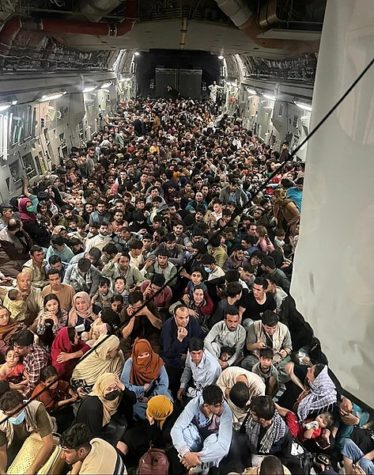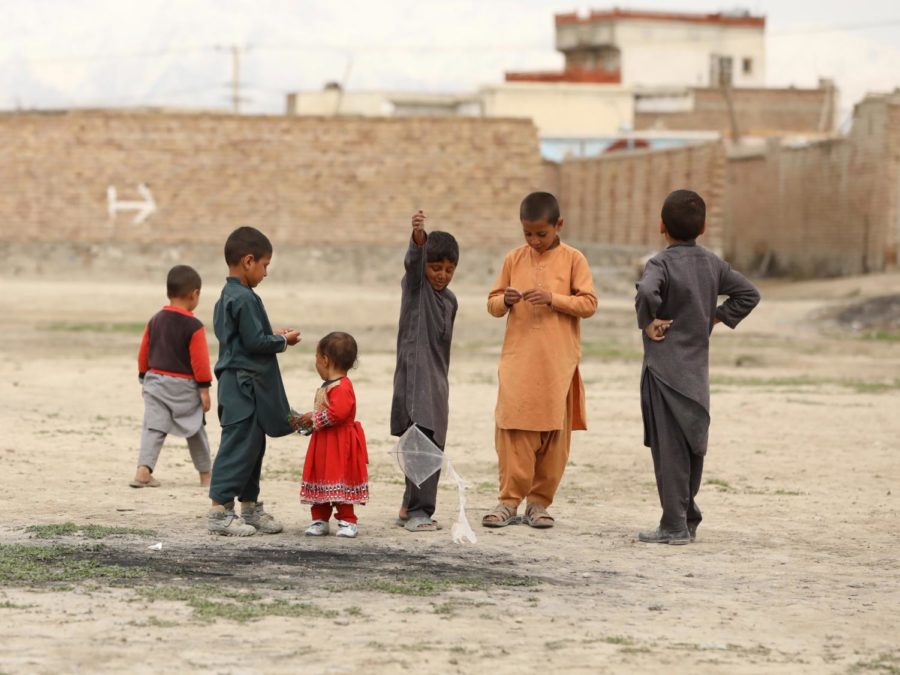Afghanistan and the Forever War
Commonly referred to as Afghanistan’s ‘Forever War,’ the Taliban insurgency in Afghanistan has culminated in a dire humanitarian crisis, worsening with each passing day.
A group of children dressed in red and gray play in Kabul, Afghanistan. This photo was taken on October 7th, 2020, a full year before the Taliban resurgence. During this time, tensions between the US and the Taliban rose once more, with Taliban attacks increasing.
December 17th, 2001. After two months of fighting, US-led military forces drove the Taliban out of Kabul as part of the Global War on Terrorism, commonly abbreviated as GWOT. The campaign, as described by the George W Bush library, is an international military campaign led by the U.S. with the purpose of curbing the global rise in terrorism, with a heavy emphasis on Muslim countries. Coming about after the tragedy of 9/11, the campaign’s first order of business was to disrupt Al-Qaeda activities. Zeroing in on Afghanistan, U.S. leaders demanded the Taliban hand over Osama Bin-Laden, who founded Al-Qaeda in 1988 during the Soviet-Afghan war. The Taliban, who had been harboring Bin-Laden, refused, and on October 7th, 2001, the U.S. invaded Afghanistan.
What was originally thought to be an easy victory spiraled into a 20 year long occupation of the country by U.S. forces as the Taliban continuously launched deadly attacks against U.S. forces. The war ended on August 30th, 2021, with President Biden’s decision to withdraw the U.S. from Afghanistan. Biden’s decision triggered the Kabul Airlifts, now considered to be one of the biggest – if not the biggest – airlift in history, with more than 120,000 people being evacuated out of the country in a little over two weeks. Thousands rushed to the Kabul International Airport, also known as the Hamid Karzai International Airport, determined to grab a seat to flee the country as the Taliban closed in. Families were ripped apart as people crowded onto flights, and in one particularly memorable headline regarding the airlifts, a baby was separated from his parents in the airport, only to be found by a taxi driver.
The scenes of desperation quickly shifted to those of horror as suicide bombers and gunmen associated with ISIS, the Islamic State, attacked the crowds as the end of the airlifts swiftly approached, killing at least 60 afghans and 13 U.S. troops. As a result, the gates were closed, and at approximately 11:59 pm local time on August 30th, 2021, a day ahead of schedule, the last flight left Kabul.

(Air Mobility Command Public Affairs, Public domain, via Wikimedia Commons)
Almost a year after the collapse of the Islamic Republic, Afghanistan is in dire straits. According to an article published by Al-Jazeera on January 5th, 2022, nearly 23 million Afghans face extreme levels of hunger, with 8.7 million suffering from famine. In a more recent report published on May 11th, 2022 by the IRC, the International Rescue Committee, it was estimated that nearly 19 million Afghans are expected to experience high levels of food insecurity in the coming months. This is the first time in almost a decade in which Afghans are experiencing famine, and it is currently the country’s “worst hunger crisis on record.” Integrated Phase Classification reports (IPC), which are a set of standardized tools used for classifying severity and magnitudes of food insecurity throughout the world, classify the situation of at least 200,000 people in Afghanistan as IPC-5, the single most alarming level of food insecurity possible. This part of the report is focused on pockets in the northeast of Afghanistan, with the province of Badakhshan determined as the most vulnerable.
To exacerbate the situation, an ever worsening drought carrying on from last year in Badghis province has devastated the region, where 90% of a population of 600,000 live off of either the fields or their livestock. Now, the drought’s effects are palpable throughout the country, with families who previously made their living off of agriculture on the brink of destitution. These households make up about 61% of Afghanistan’s population. Forced to sell off livestock to support themselves, families have turned to marrying off their daughters at increasingly younger ages in order to prop themselves up financially, as well as taking their children out of work and placing them in jobs to make ends meet. One such province ravaged by the drought is Faryab, located in the north of Afghanistan, where more than a quarter of people are reliant on aid for almost half of their daily needs. Access to drinking water has also become a desperate bid for many living in Afghanistan’s rural areas, the drought drying up many wells relied upon for water. The Kabul River in particular has experienced a turn for the worse as well, with the water supply being declared unfit for drinking.
Foreign aid, which could have been used to curb the famine, is all but obsolete after the Taliban’s takeover. About 80 percent of the previous government’s budget came from foreign aid; now, that’s a figment of the past, as the Taliban’s rise to power has caused various countries to cut off their financial assistance. The U.S. confiscated more than $7 billion in international reserves from Afghanistan’s central bank, needed for essential imports such as food and medicine. The money also allows the bank to maintain its normal role as a stabilizer of the country’s economy, strengthening the financial sector as well as managing the currency reserves.
Back in February 2022, the Biden Administration announced that it would split the bank’s funds in half, using one portion to pay families of victims of 9/11 and the other for an ambiguous trust fund designed to benefit the Afghan people. This announcement faced waves of backlash, particularly from families of 9/11 victims, stating they’d rather the money go fully towards re-stabilizing Afghanistan. More recently, there has been a movement amongst exiled Afghanistan’s to push back against this decision.
Afghanistan’s economy has been in a free fall ever since August 2021, with numerous sanctions imposed against the country. As a result of these sanctions, aid groups have a difficult time moving aid, including financial assistance, into the country. While there has been limited economic assistance from a variety of other countries, it is still nowhere near enough to haul Afghanistan’s economy back up. After the U.S. occupation, many Afghans worked as journalists, photographers, translators, and teachers under the new government; now, these people have been pushed out of their jobs, or forced into hiding as a result of the insurrection. This further hampers the ability of many Afghans to receive basic necessities.

Hospitals throughout Afghanistan have also been on the brink of collapse, with many lacking basic resources to provide adequate care of their patients. What was once a mundane illness can quickly turn life threatening as Afghan hospitals lack medicine for treatment. Hospitals and clinics are packed, with little space able to be provided for the ever expanding lines of people in need. Most health care workers have not been paid by the Taliban in months, instead relying on money given to them by the IRC.
Perhaps the most devastating effect of the Taliban resurgence is the destruction of two decades of reforms made towards civil liberties in Afghanistan. One well known struggle, used to justify the war in Afghanistan by the Bush administration, is women’s rights. The Taliban is well known for its conservative views on women’s rights, requiring full body coverings and limiting freedom of movement for women. The relative freedoms established for women in the past two decades have disappeared underneath the Taliban, with women no longer able to leave their houses without harassment if they do not have a mahram with them, a close adult male relative.
The already small public sphere for women grows increasingly smaller as the Taliban limits the number of women allowed positions in the government and in the workforce. The regime also mandates women don the chador, a long, cape-like garment that leaves only the face visible. For middle aged women, the burqa is what the Taliban states they should wear in order to “avoid provocation when meeting men who are not mahram.” Later, they extended this decree further, requiring female reporters to cover their faces when on air.
Girls’ education in particular has received a variety of blows from the Taliban, as higher education for girls has been rejected by the Taliban. Now, girls are only allowed to receive education until the 6th grade, going against a previous ruling that would allow girls to gradually return to all female classrooms. This decision has been met by a flood of outrage, with many Afghan families relocating to Iran in response. Taliban affiliated clerics have also spoken up in defense of girls’ education, though with the mindset that it would allow girls to become better mothers in the future instead of empowering them.
When asked about how this would possibly affect the future of the country, Ms. Elizabeth MacEnulty, an AP World History teacher, states, “ I am not an expert in foreign affairs, but I think when you take half the population out of public life and deny them access to education and professional advancement that the advancement of the nation suffers as a whole.” Judging by reports published by the Human Rights Watch, this is an apt assessment of the situation at hand, as education comes under attack.
Queer Afghans, in particular, have faced immense danger. While Afghanistan was far from a paradise for queer people both before and after U.S. interference, the Taliban has sought to further stigmatize the LGBTQ+ community in Afghanistan, forcing many to live in hiding. Targeted attacks on queer afghans have risen across the country, with many disappearing off of social media in fear of being traced by the Taliban. Members of the queer community have been attempting to leave the country to seek safety abroad, with very limited success. Those who had to stay inside the country report facing record levels of abuse from family and friends, who now either support the Taliban or who have claimed it as a self-preservation method.
The Hazara, one of Afghanistan’s many ethnic minorities, has faced a litany of ever increasing attacks for the past few months. The Hazara, a group that practices the Shia branch of Islam in a historically Sunni majority country, has been persecuted for centuries, and is considered Afghanistan’s most discriminated against ethnic group. The Taliban have previously targeted the Hazara community en masse, forcibly evicting them from their homes as well as attacking mosques and schools. While the Taliban had previously stated that they were committed to respecting ethnic minority groups in the country, the reality of how these groups are treated is far different as extremist groups such as ISIS-K routinely target these communities. The Taliban has done almost nothing to ensure the safety of the Hazara, either unwilling or unable to do so. As a result of this negligence, the Hazara community has been in a constant state of fear as attacks grow more and more deadly. With the dissolution of Afghanistan’s human rights commission by the Taliban, things seem to grow ever bleaker for the marginalized in the country.
As the human rights abuses in Afghanistan ramp up, so too does opposition towards the Taliban. Panjshir, a province considered a bastion of anti-Taliban resistance, has broken into fighting as anti-Taliban forces clash with the extremist group. It originally started as a religious dispute between a cleric based in Panjshir who disagreed with the date the Taliban declared as Eid, causing the Taliban to arrest him. Assisting the opposition in the fight was the National Resistance Front, otherwise known as the NRF, primarily made up of soldiers who had formerly served under the Western backed government. Upon the Taliban’s regaining of control in Afghanistan, many of these former soldiers lost their places in the military. Banking on the current volatility of the situation in the country as well as the ever increasing weariness amongst Afghanistan’s neighbors towards the country, the NRF hopes their efforts will culminate in a revolt against the Taliban. Tensions between Pakistan and Afghanistan in particular have been on the rise as Pakistani air raids into the country have allegedly killed at least 50 people.
In the face of numerous other global disasters that have emerged in recent months, the conflict in Afghanistan has faded from the screens of the American public. As the international community shifts their attention to the Russia-Ukraine conflict amongst others, it is imperative to not forget nor turn a blind eye to the suffering faced by millions of Afghans as their rights, and their very lives, are ripped away from them.
Almost a year after the collapse of the Islamic Republic, Afghanistan is in dire straits.
Nehla Chowdhury is an Editor-in-Chief for 'The Science Survey,' as well as a Social Media Editor. Nehla enjoys researching topics for their articles, as...

